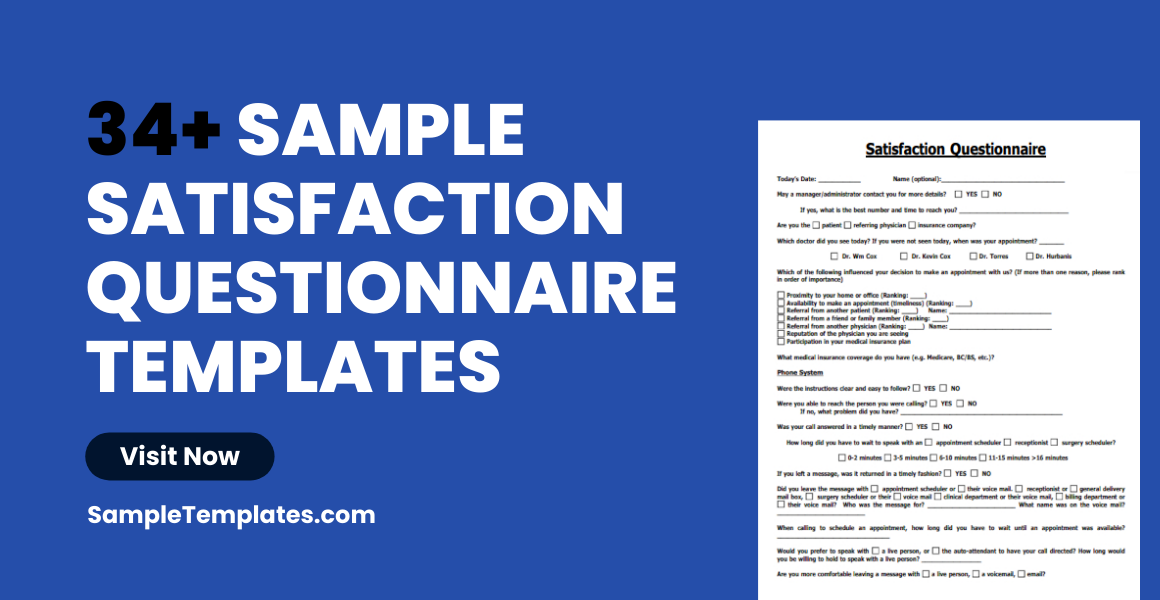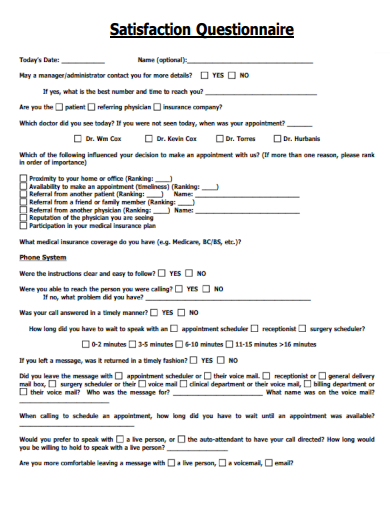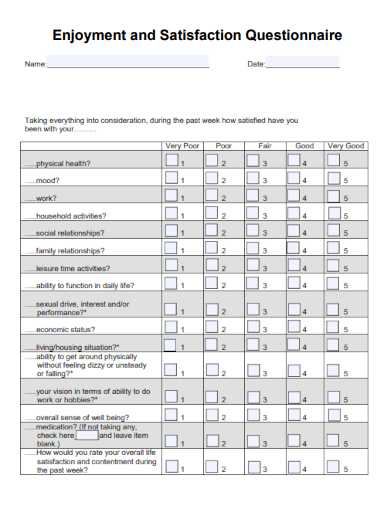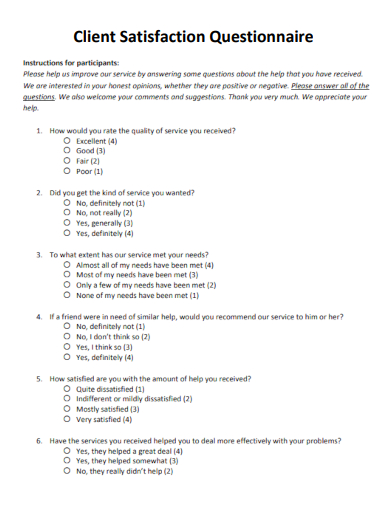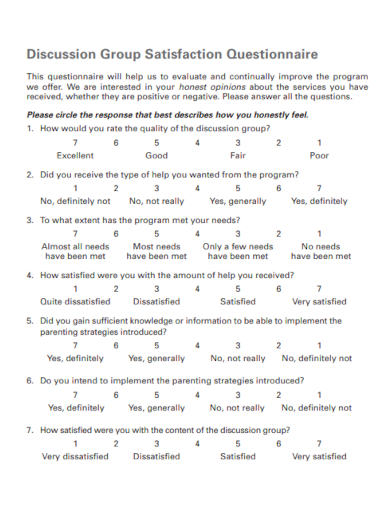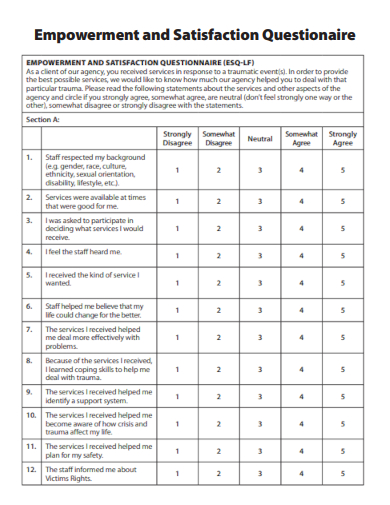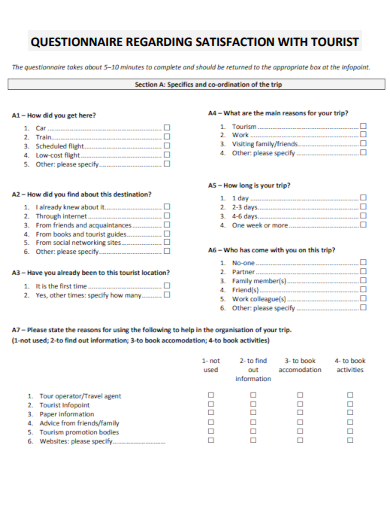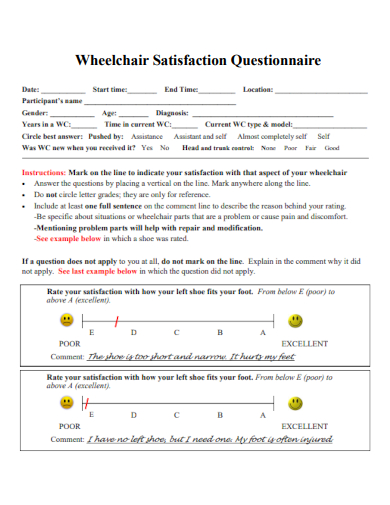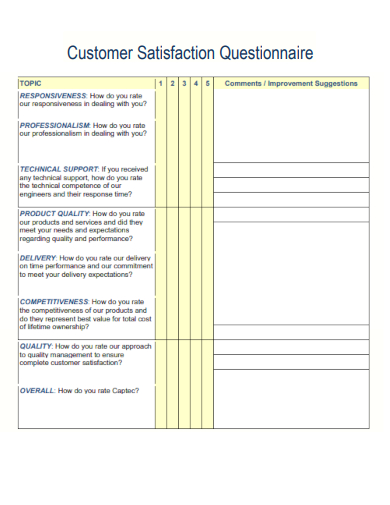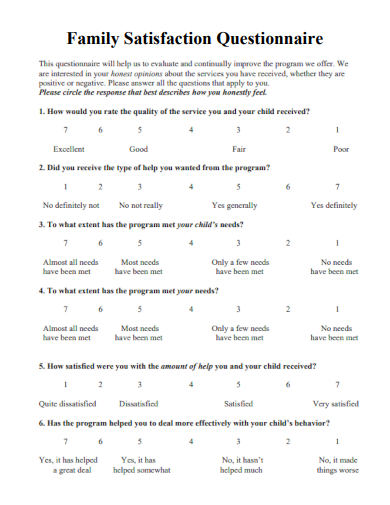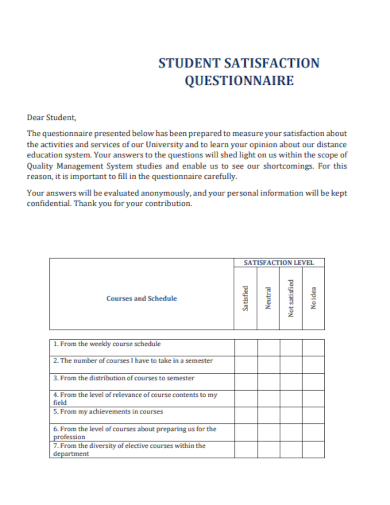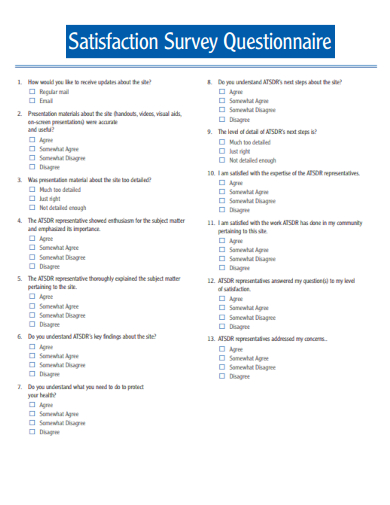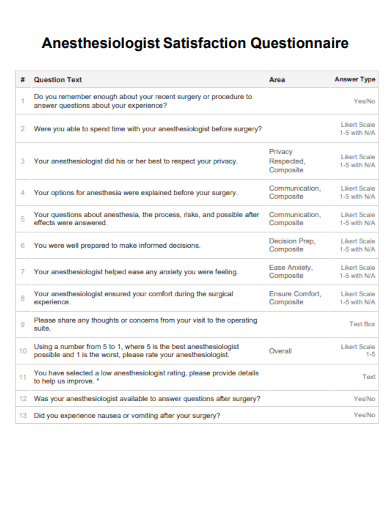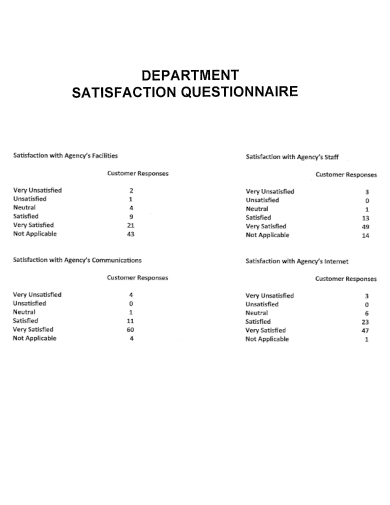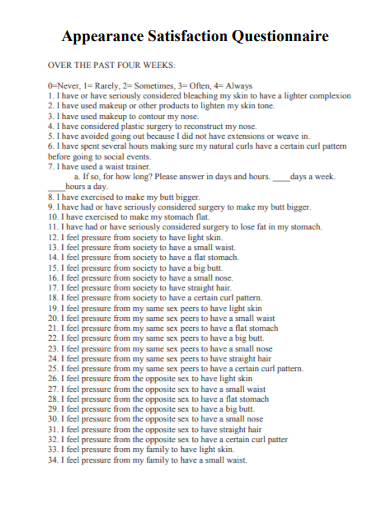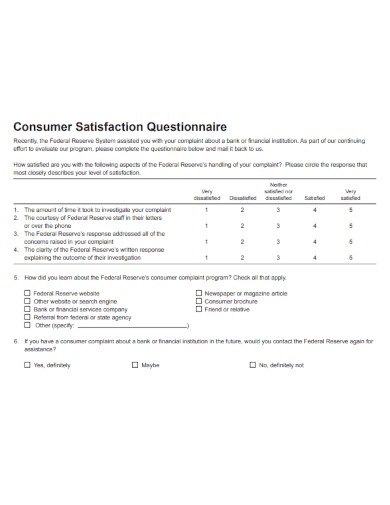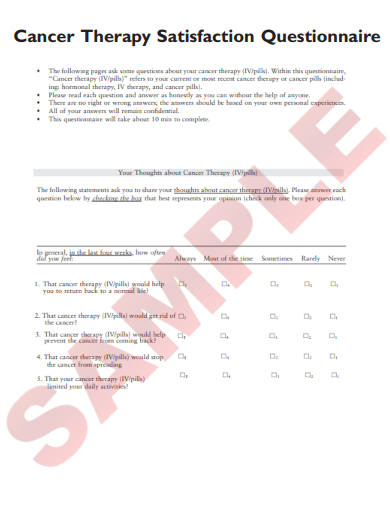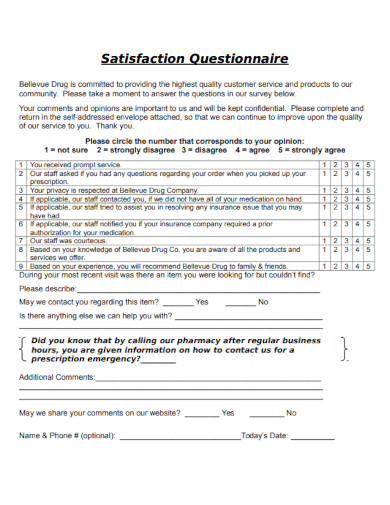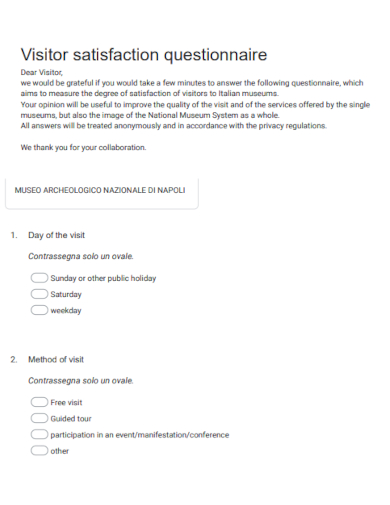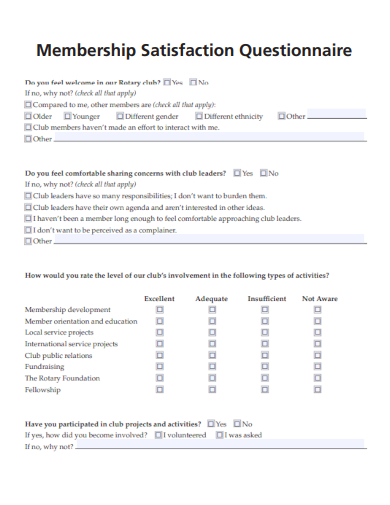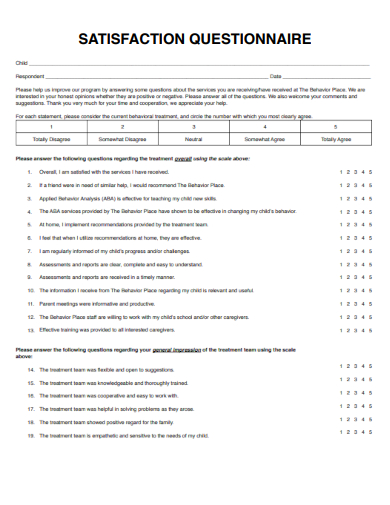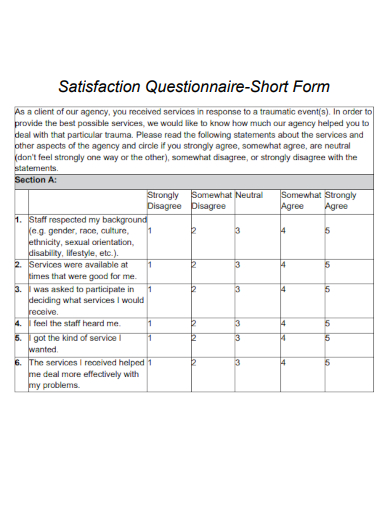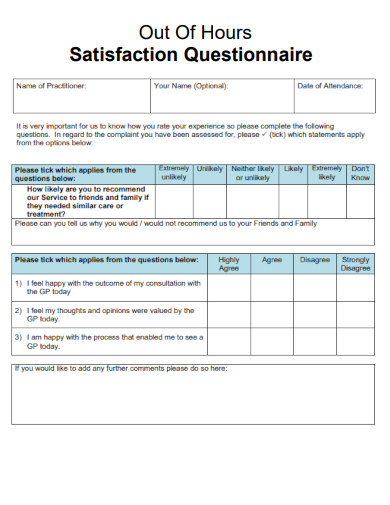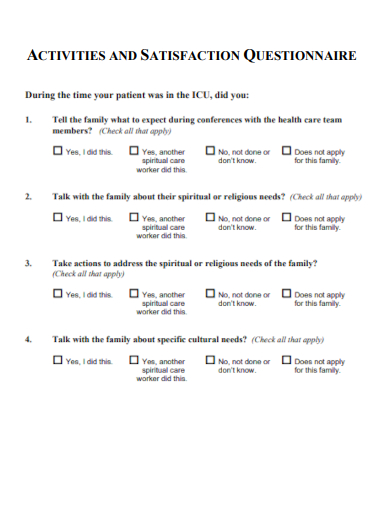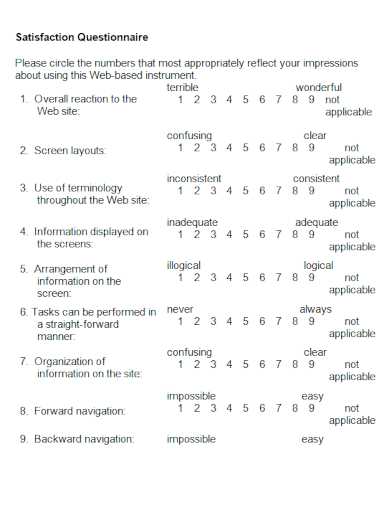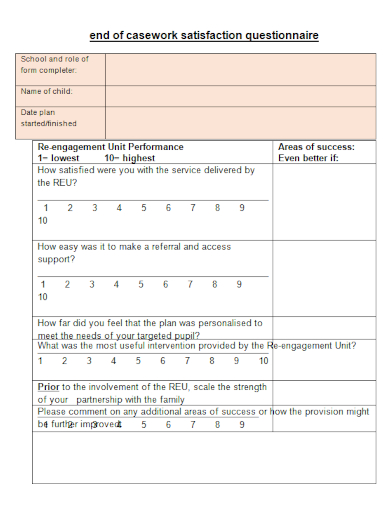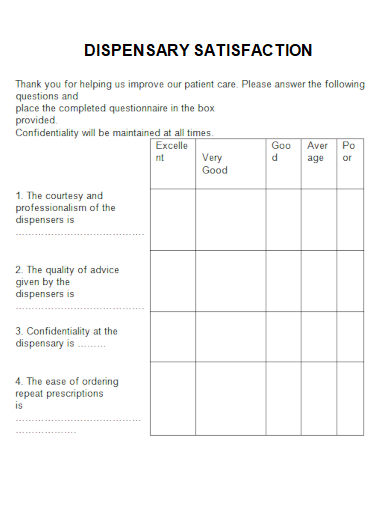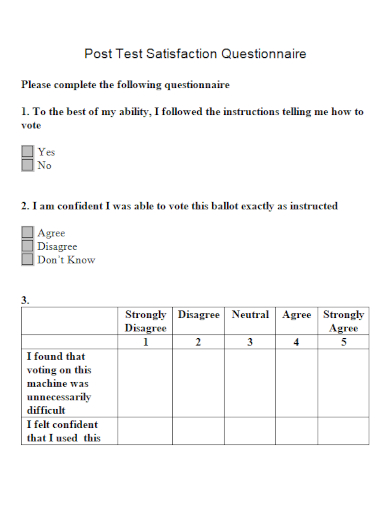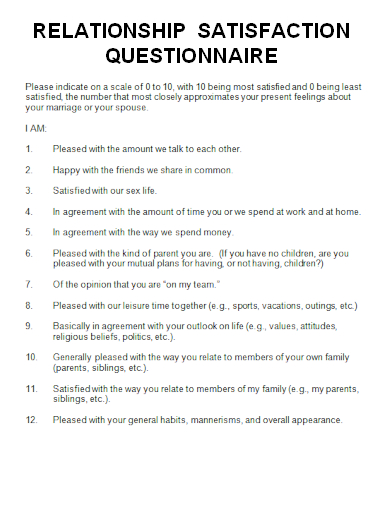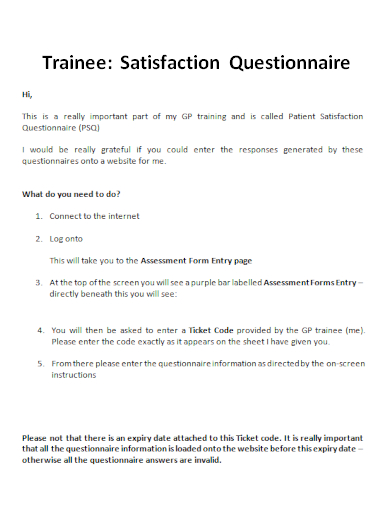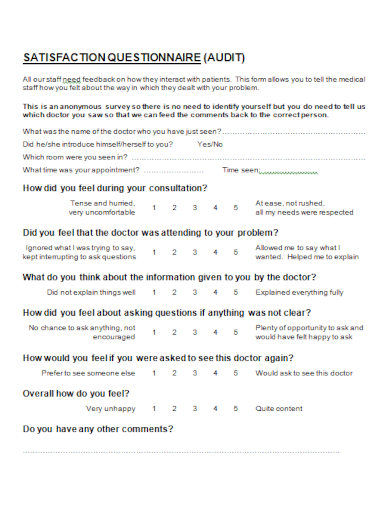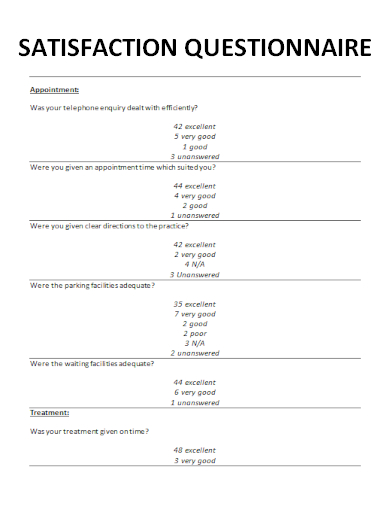Unveil the power of feedback with our Sample Satisfaction Questionnaire Template. Expertly crafted to gauge user experiences and preferences, this template harnesses the essential questions that drive improvement. Dive into a treasure trove of insights, refine your strategies, and elevate satisfaction rates. Whether you’re a startup or an industry leader, our sample questionnaire is the key to unlocking invaluable feedback. Ready to optimize and excel? Start with our comprehensive tool today.
FREE 34+ Satisfaction Questionnaire Samples
1. Job Satisfaction Questionnaire Template
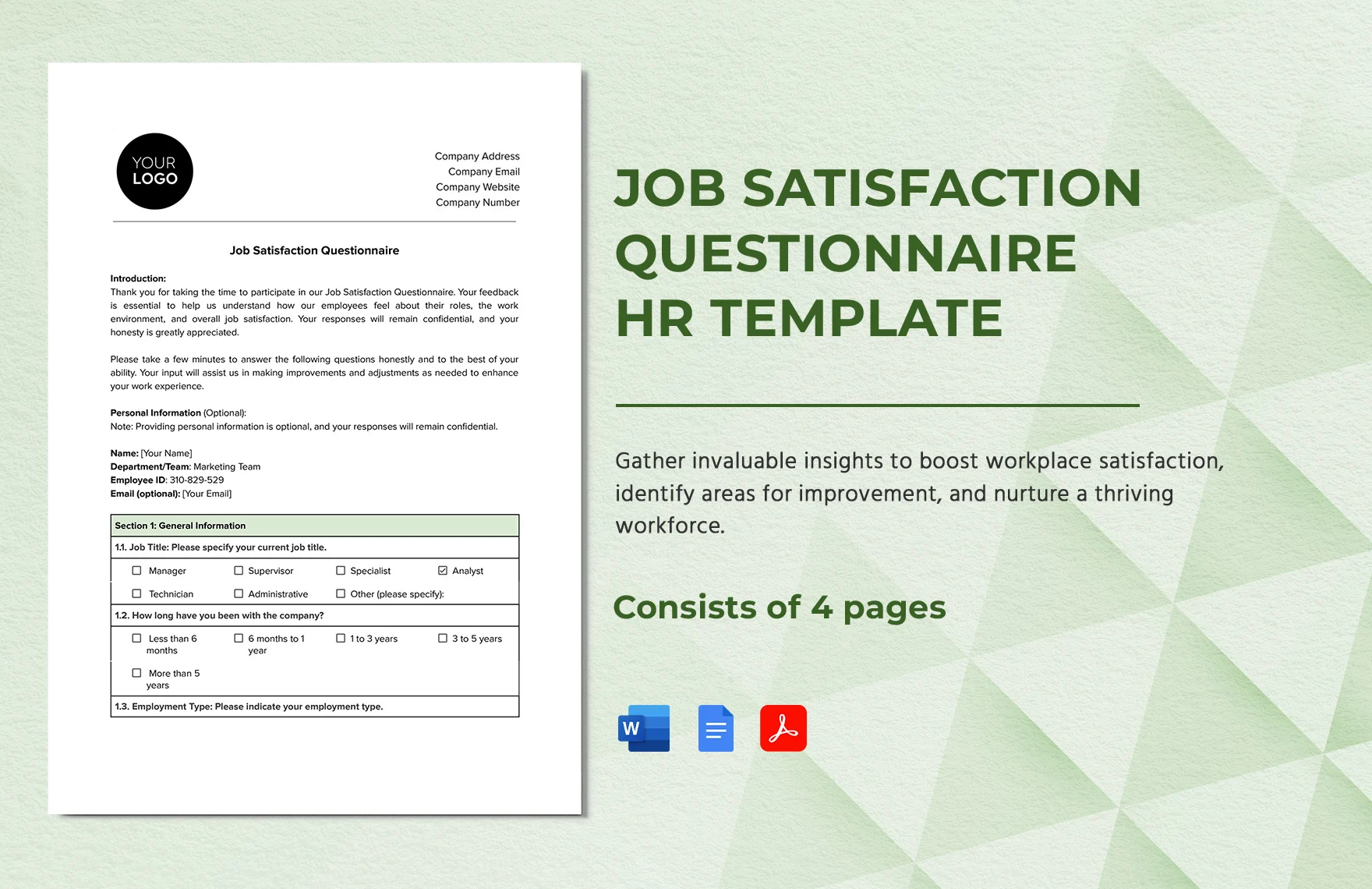
2. Sample Satisfaction Questionnaire Template
3. Sample Enjoyment and Satisfaction Questionnaire Template
4. Sample Client Satisfaction Questionnaire Template
5. Sample Discussion Group Satisfaction Questionnaire Template
6. Sample Empowerment and Satisfaction Questionnaire Template
7. Sample Tourist Satisfaction Questionnaire Template
8. Sample Wheelchair Satisfaction Questionnaire Template
9. Sample Customer Satisfaction Questionnaire Template
10. Sample Family Satisfaction Questionnaire Template
11. Sample Student Satisfaction Questionnaire Template
What is a Satisfaction Questionnaire?
A satisfaction questionnaire is a structured tool, typically in the form of a series of questions, designed to gauge the contentment, approval, or happiness of individuals with respect to a particular product, service, event, or experience. By collecting responses, organizations or researchers can gain insights into how well they are meeting the needs and expectations of their target audience or stakeholders.
Purpose and Importance
The primary purpose of a satisfaction questionnaire is to collect feedback. Whether you’re a business seeking to understand how customers feel about your latest product, an institution trying to determine the effectiveness of its services, or an event organizer curious about attendees’ experiences, these questionnaires provide a quantifiable measure of success.
In today’s competitive marketplace, understanding and addressing the needs of clients or customers is paramount. Satisfaction questionnaires offer a direct line of communication to those users, allowing organizations to:
Identify Strengths and Weaknesses: By understanding areas where satisfaction is high, companies can recognize what they’re doing right. Conversely, areas of low satisfaction can highlight necessary improvements.
Make Informed Decisions: Data-driven decisions often lead to better outcomes. Responses from these questionnaires can guide future business strategies, product enhancements, or service modifications.
Build Loyalty: Demonstrating to customers or users that their feedback is valued and acted upon can foster loyalty and increase retention.
Key Components
A well-constructed satisfaction questionnaire usually consists of the following elements:
Clear Objectives: Before crafting questions, it’s vital to understand what you aim to achieve with the feedback. Whether it’s improving a product or refining a service, clear objectives guide the type of questions asked.
Scale Questions: These questions allow respondents to rate their satisfaction on a scale, typically ranging from ‘Very Unsatisfied’ to ‘Very Satisfied’. This format offers a straightforward way to quantify feelings.
Open-ended Questions: These provide respondents an opportunity to express their thoughts in their own words, often yielding more in-depth insights.
Demographic Questions: Understanding who is providing feedback (e.g., age, gender, location) can offer context to responses and highlight trends among certain groups.
Methods of Distribution
With the advancement of technology, satisfaction questionnaires can be shared in various ways:
Online Surveys: Tools like SurveyMonkey or Google Forms allow for easy creation and distribution of digital questionnaires.
Physical Forms: In some contexts, especially when immediate feedback is sought (like after attending an event), paper-based questionnaires can be effective.
Email: For clients or users with whom you have an existing relationship, sending questionnaires via email can ensure higher response rates.
Mobile Apps: Businesses with mobile apps can integrate questionnaires to capture user feedback in real-time.
In essence, a satisfaction questionnaire is a crucial tool for continuous improvement. By systematically collecting and analyzing feedback, organizations can ensure they remain responsive to the needs and desires of their audiences. In an age where consumer opinions can swiftly affect reputations and bottom lines, deploying well-designed satisfaction questionnaires is not just advisable it’s imperative.
12. Sample Satisfaction Survey Questionnaire Template
13. Sample Anesthesiologist Satisfaction Questionnaire Template
14. Sample Department Satisfaction Questionnaire Template
15. Sample Appearance Satisfaction Questionnaire Template
16. Sample Consumer Satisfaction Questionnaire Template
17. Sample Cancer Therapy Satisfaction Questionnaire Template
18. Sample Satisfaction Questionnaire Basic Template
19. Sample Visitor Satisfaction Questionnaire Template
20. Sample Membership Satisfaction Questionnaire Template
21. Sample Satisfaction Questionnaire Formal Template
The Importance of Customer Satisfaction questionnaire
In today’s fast-paced business landscape, understanding the needs, preferences, and sentiments of customers is crucial for success. Enter the customer satisfaction questionnaire, a powerful tool designed to gauge the overall happiness and approval levels of customers concerning a product, service, or experience. Its importance cannot be understated, and here’s why.
Puts the Customer at the Forefront
Businesses thrive when customers are satisfied, and falter when they’re not. A customer satisfaction questionnaire allows organizations to hear directly from the people who matter most: the customers. This direct line of feedback ensures businesses stay attuned to evolving needs and can pivot or innovate as required.
Unearths Actionable Insights
While sales figures and revenue streams provide a numeric indication of success, they don’t paint the full picture. It’s possible to have high sales and still have discontented customers. By analyzing the responses from satisfaction questionnaires, businesses can uncover areas for improvement and develop strategies that address specific pain points, ultimately leading to a better product or service.
Builds Trust and Loyalty
When customers see that a company values their feedback and makes tangible efforts to address concerns, it fosters a sense of trust. Trust, in turn, often translates into loyalty. Loyal customers not only provide consistent revenue but also become brand ambassadors, spreading positive word of mouth and amplifying the brand’s reach.
Reduces Customer Churn
It’s a well-acknowledged business axiom that retaining an existing customer is cheaper than acquiring a new one. By routinely deploying satisfaction questionnaires and acting on the feedback, businesses can address issues before they escalate, thereby reducing the number of customers who might otherwise switch to competitors.
Provides Competitive Edge
In industries where multiple businesses offer similar products or services, understanding customer sentiments can be a differentiating factor. A company that continually refines its offerings based on customer feedback is more likely to stand out and capture a larger market share.
Facilitates Proactive Approach
Rather than waiting for customers to voice complaints, satisfaction questionnaires allow businesses to proactively gauge sentiments. This proactive stance can often detect and resolve issues before they balloon into larger problems.
Enhances Overall Business Strategy
Beyond product or service refinements, feedback from these questionnaires can guide broader business decisions, from marketing strategies to resource allocation. By keeping the customer voice central, businesses ensure their strategies resonate with the market.
In an era where the voice of the customer has unprecedented power—thanks to social media and online reviews—a customer satisfaction questionnaire is an indispensable tool. It serves as a barometer for overall customer sentiment, providing invaluable data that can steer business growth. In essence, such questionnaires bridge the gap between businesses and their audiences, fostering a relationship built on understanding, trust, and mutual benefit.
22. Sample Satisfaction Questionnaire Short Form Template
23. Sample Out Of Hours Satisfaction Questionnaire Template
24. Sample Satisfaction Questionnaire in Linguistic Study Template
25. Sample Activities & Satisfaction Questionnaire Template
26. Sample Satisfaction Questionnaire Standard Template
27. Sample End of Casework Satisfaction Questionnaire Template
28. Sample Dispensary Satisfaction Questionnaire Template
29. Sample Post Test Satisfaction Questionnaire Template
30. Sample Massage Client Satisfaction Questionnaire Template
31. Sample Relationship Satisfaction Questionnaire Template
32. Sample Trainee Satisfaction Questionnaire Template
33. Sample Satisfaction Questionnaire Audit Template
34. Sample Satisfaction Questionnaire Editable Template
35. Sample Teacher Job Satisfaction Questionnaire Template
How To Use a Customer Satisfaction Survey
Understanding customer sentiments is crucial for any business aiming to deliver superior products or services. A customer satisfaction survey is an instrumental tool in this endeavor. When executed correctly, it can provide invaluable insights, steer company direction, and foster stronger customer relationships. Here’s how to make the most of this potent tool:
Defining Your Objectives
Before diving into crafting questions, it’s essential to understand what you hope to achieve. Are you keen on gauging overall satisfaction, or do you have specific facets of your service or product you’d like feedback on? A clear objective ensures your survey is focused, relevant, and capable of delivering actionable insights.
Crafting the Right Questions
An effective survey strikes a balance between open-ended questions and structured ones. While options like multiple-choice or Likert scales offer quantifiable data, open-ended questions provide deeper, qualitative insights into customer sentiments. Also, clarity is paramount; ensure every question is straightforward and devoid of jargon. A good practice is to pilot your survey within a small group, tweaking based on their feedback before rolling it out on a larger scale.
Optimal Distribution Channels
The method of survey distribution can significantly influence its success. Digital tools have revolutionized survey distribution, with platforms like SurveyMonkey being immensely popular. Depending on your customer base, consider email surveys for those you have direct contact with, or utilize social media if your audience is highly active there. For businesses with physical interfaces, in-store or event-based paper surveys can be effective. Meanwhile, digital platforms or apps can embed surveys to capture real-time feedback.
Deep Dive into Analysis
Once responses roll in, it’s time for analysis. While structured responses can be easily quantified to glean trends, pay close attention to open-ended answers. They often house rich feedback, pinpointing specific areas of improvement or innovation. Using statistical tools or even integrated analytics within survey platforms can help visualize and understand these results better.
Taking Constructive Action
Raw data and insights only matter if acted upon. Address concerns and areas of improvement highlighted by the survey. Similarly, reinforce and possibly expand aspects that receive positive feedback. If customers took the time to provide feedback, they’d appreciate seeing tangible changes in response.
Engaging with Respondents
Communication is a two-way street. After collating results and implementing changes, circle back to your audience. Inform them of the changes made based on their feedback. This not only fosters trust but also emphasizes your commitment to their satisfaction.
Periodic Re-assessment
The business landscape and customer preferences continually evolve. To stay aligned with your customers, periodically run satisfaction surveys. This ongoing feedback loop ensures your offerings remain relevant and continually refined based on actual user experiences.
In conclusion, a customer satisfaction survey, when used effectively, is much more than a feedback tool. It’s a strategic instrument that helps businesses adapt, innovate, and build enduring relationships with their customers. The key lies in its thoughtful execution and the proactive implementation of its findings.
Related Posts
Sample Business Card Templates
Sample Cashier Job Descriptions
Questionnaire Samples
FREE 10+ Sample HR Resource Templates in PDF
FREE 10+ HR Consulting Business Plan Samples in MS Word | Google Docs | Pages | PDF
FREE 49+ Sample Job Descriptions in PDF | MS Word
FREE 16+ Nonprofit Budget Samples in PDF | MS Word | Excel | Google Docs | Google Sheets | Numbers | Pages
FREE 13+ Academic Calendar Templates in Google Docs | MS Word | Pages | PDF
FREE 10+ How to Create an Executive Summary Samples in Google Docs | MS Word | Pages | PDF
FREE 23+ Sample Event Calendar Templates in PDF | MS Word | Google Docs | Apple Pages
Company Profile Samples
FREE 10+ Leadership Report Samples [ Development, Training, Camp ]
FREE 24+ Sample Payment Schedules in PDF | MS Word
FREE 10+ Return to Work Action Plan Samples in PDF | DOC
Autobiography Samples & Templates
